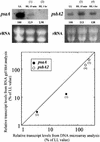DNA microarray analysis of cyanobacterial gene expression during acclimation to high light
- PMID: 11283337
- PMCID: PMC135531
- DOI: 10.1105/tpc.13.4.793
DNA microarray analysis of cyanobacterial gene expression during acclimation to high light
Abstract
DNA microarrays bearing nearly all of the genes of the unicellular cyanobacterium Synechocystis sp PCC 6803 were used to examine the temporal program of gene expression during acclimation from low to high light intensity. A complete pattern is provided of gene expression during acclimation of a photosynthetic organism to changing light intensity. More than 160 responsive genes were identified and classified into distinct sets. Genes involved in light absorption and photochemical reactions were downregulated within 15 min of exposure to high light intensity, whereas those associated with CO(2) fixation and protection from photoinhibition were upregulated. Changes in the expression of genes involved in replication, transcription, and translation, which were induced to support cellular proliferation, occurred later. Several unidentified open reading frames were induced or repressed. The possible involvement of these genes in the acclimation to high light conditions is discussed.
Figures




References
-
- Anderson, J.M. (1986). Photoregulation of the composition, function, and structure of thylakoid membranes. Annu. Rev. Plant Physiol. 37, 93–136.
-
- Anderson, J.M., Chow, W.S., and Park, Y.-I. (1995). The grand design of photosynthesis: Acclimation of the photosynthetic apparatus to environmental cues. Photosynth. Res. 46, 129–139. - PubMed
-
- Anderson, J.M., Park, Y.-I., and Chow, W.S. (1997). Photoinactivation and photoprotection of photosystem II in nature. Physiol. Plant. 100, 214–223.
-
- Appel, J., and Schulz, R. (1996). Sequence analysis of an operon of a NAD(P)-reducing nickel hydrogenase from the cyanobacterium Synechocystis sp. PCC 6803 gives additional evidence for direct coupling of the enzyme to NAD(P)H-dehydrogenase (complex I). Biochim. Biophys. Acta 1298, 141–147. - PubMed
Publication types
MeSH terms
Substances
LinkOut - more resources
Full Text Sources
Other Literature Sources

